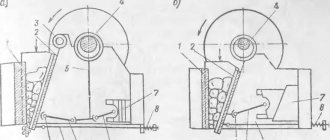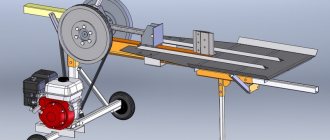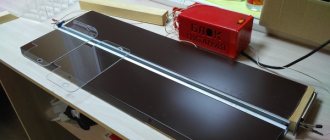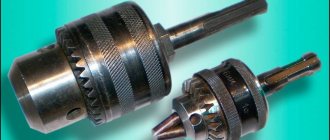Plastic processing is one of the freest niches for doing business in Russia.
However, the issue of opening it most often depends on the cost of the equipment.
Entrepreneurs often start not with a full processing cycle with finished granulate at the output, but with the collection and grinding of polymer waste.
Even in this case, purchasing a shredder and/or crusher may not be affordable . One of the most discussed solutions to the problem is making your own shredder.
Such projects are quite feasible if two “constant quantities” are known - raw materials and product.
Next, we will talk about how to make a shredder and how to avoid gross mistakes when designing and making your own plastic crusher.
What is the difference between a shredder and a polymer crusher?
Both types of equipment perform the same task - crushing.
When processing plastics, this process is usually divided into two stages :
- coarse grinding - shredders are used for this;
- obtaining fine crumbs - a crusher is used for this.
The operating principle and kinematics of both units are most often the same, and they differ only in some details, for example, the size of the sieve cell, the overlap of the knives and the configuration of the cutting edges.
The process is divided into two stages in order to increase productivity and optimize energy costs.
Useful tips
- Users who make crushers for PET bottles with their own hands are advised to draw a drawing of the unit before starting. This will allow the equipment to be manufactured exactly as planned and will prevent missing parts.
- When purchasing a motor, you should understand what volumes of raw materials the plastic crusher will encounter. The quality and speed of grinding depends on the power of the device. An oversized electric motor is suitable for periodic processing of materials. If volumes will increase in the future, it is better to choose a powerful motor in advance.
- The design should be designed to be easily accessible for removing any element of the device, for example, circular saws for sharpening. To avoid having to take out the latter too often, it is better to initially choose light-alloy cutters. Their cost is higher, but the preservation of a good sharpening is high, which will make it possible to grind longer at home.
- To ensure that recycled raw materials are in one place, it is useful to consider a container for collecting plastic. It is usually installed under the crusher blades. If you want to sort the cut plastic by size, homemade gratings or mesh elements with a given cell size are mounted below the disks.
- Making your own PET crusher benefits the environment and the owner of the device. When using it, nature is not polluted by non-degradable plastic bottles, and the master has the opportunity to hand over the recycled material to a waste collection point.
- If the structural part of a home-made unit is properly designed, the shredder will not only crush the raw materials, but also process the leaves and branches - for a gardener this will be an excellent alternative to burning branches on a fire by hand.
All types of processing machines are available for DIY production. Technology develops over time, allowing users to improve the unit. A plastic crusher made at home is no worse than a factory one and will definitely be more reliable than budget Chinese devices.
Shredder design for plastics
When choosing the design of a plastic shredder, you should pay attention to the proposals of equipment manufacturers.
It is better to take other people’s work as a basis for a project and have certain guidelines than to reinvent the wheel and end up with a non-working model.
The most popular are single- and double-shaft rotary shredders.
Single-shaft
Single shaft shredders are used for the initial shredding of most varieties of polymers .
It consists of a rotor on which movable knives (2) are fixed and a housing with fixed or stator knives (1). The raw materials are fed through the loading window from above, and the finished crumbs are poured under their own weight through the calibrating sieve (3).
The shredding process involves repeated cutting and continues until all the plastic has gone into the receiving hopper.
The configuration of the rotary knives is selected depending on the material being processed:
- Dovetail and inclined – for processing film materials, PET containers and other soft waste.
- Straight – for crushing sprues, boxes, thick-walled blow moldings, PET bottle caps. Such knives are often made in the form of separate segments, which are arranged in cascades. Segmentation is performed to reduce shock loads on the drive, reduce noise and vibration.
Stator knives for single-shaft polymer crushers are made solid (type P).
Twin-shaft
The rotor and stator knives on such crushers are arranged in a checkerboard pattern, and the shafts rotate in counter directions.
Low-productivity machines with a small working chamber are made with a single drive ; the teeth on the rotary knives are used to capture and crush waste.
Grinding is also performed on the side surfaces (as in disc shears).
Do-it-yourself crusher for PET bottles
Plastic processing is one of the freest niches for doing business in Russia.
However, the issue of opening it most often depends on the cost of the equipment.
Entrepreneurs often start not with a full processing cycle with finished granulate at the output, but with the collection and grinding of polymer waste.
Even in this case, purchasing a shredder and/or crusher may not be affordable . One of the most discussed solutions to the problem is making your own shredder.
Such projects are quite feasible if two “constant quantities” are known - raw materials and product.
Next, we will talk about how to make a shredder and how to avoid gross mistakes when designing and making your own plastic crusher.
What is the difference between a shredder and a polymer crusher?
Both types of equipment perform the same task - crushing.
When processing plastics, this process is usually divided into two stages :
- coarse grinding - shredders are used for this;
- obtaining fine crumbs - a crusher is used for this.
The operating principle and kinematics of both units are most often the same, and they differ only in some details, for example, the size of the sieve cell, the overlap of the knives and the configuration of the cutting edges.
The process is divided into two stages in order to increase productivity and optimize energy costs.
Shredder design for plastics
When choosing the design of a plastic shredder, you should pay attention to the proposals of equipment manufacturers.
It is better to take other people’s work as a basis for a project and have certain guidelines than to reinvent the wheel and end up with a non-working model.
The most popular are single- and double-shaft rotary shredders.
Single shaft shredders are used for the initial shredding of most varieties of polymers .
It consists of a rotor on which movable knives (2) are fixed and a housing with fixed or stator knives (1). The raw materials are fed through the loading window from above, and the finished crumbs are poured under their own weight through the calibrating sieve (3).
The shredding process involves repeated cutting and continues until all the plastic has gone into the receiving hopper.
The configuration of the rotary knives is selected depending on the material being processed:
- Dovetail and inclined – for processing film materials, PET containers and other soft waste.
- Straight – for crushing sprues, boxes, thick-walled blow moldings, PET bottle caps. Such knives are often made in the form of separate segments, which are arranged in cascades. Segmentation is performed to reduce shock loads on the drive, reduce noise and vibration.
Stator knives for single-shaft polymer crushers are made solid (type P).
Where can I get the drawings?
You need to understand that manufacturers of equipment for shredders and crushers will not make drawings publicly available .
The easiest way to get diagrams for a homemade shredder or crusher is in two ways:
- Read forums on the topic , like this one. The likelihood of finding accurate and detailed drawings of plastic shredders is very low. Often, resource users recycle some unclaimed equipment from a related industry, for example, a lopper. And if a crusher is made from scratch, few people care about documenting all stages of production. Nevertheless, it’s worth reading the forums: analyzing discussions and other people’s design mistakes will help you make a more advanced plastic shredder with your own hands.
- Take measurements from the existing shredder. It will not be possible to obtain complete information, since the owner will not allow you to disassemble a working machine. But even a visual assessment will help in making your own homemade crusher.
Many attempts to make a crusher on their own reach a dead end due to the fact that the designer tries to attach to an existing unit . For example, “fit” all the elements to a worm gearbox found in the garage.
An attempt to reduce the cost of a design using secondary parts, as a rule, leads to mistakes.
It is better to start production with a clear definition of the tasks of the shredder, that is, you need to know the type and quantity of raw materials being processed, and the size of the output fraction.
After this, we find a model from any well-known manufacturer that fits these parameters and take its technical characteristics :
- engine power;
- loading window dimensions;
- number and diameter of rotors;
- knife configuration.
Drive design
In factory crushing plants, two methods are used to transmit rotation from the motor to the gearbox:
- Direct drive (via clutch). Torque transmission occurs without loss, the design is compact in size. If you manage to select a ready-made geared motor, the dimensions and weight of the installation will be even smaller. However, in this case, it is necessary to provide for manual (and ideally automatic) reversing in case of jamming of the rotors.
- Belting . Efficiency losses and relatively high dimensions are compensated by the smooth start of the mechanism. If the shredder becomes jammed, the only risk is that the belt will break or slip.
The transmission of rotation between the rotors (in the case of using one engine) is most often carried out through an open gear drive. When designing, you need to be prepared to calculate it. Most likely, gears will have to be ordered .
Knives
Finding a suitable knife configuration is not difficult.
Where can I get the drawings?
You need to understand that manufacturers of equipment for shredders and crushers will not make drawings publicly available .
The easiest way to get diagrams for a homemade shredder or crusher is in two ways:
- Read forums on the topic , like this one. The likelihood of finding accurate and detailed drawings of plastic shredders is very low. Often, resource users recycle some unclaimed equipment from a related industry, for example, a lopper. And if a crusher is made from scratch, few people care about documenting all stages of production. Nevertheless, it’s worth reading the forums: analyzing discussions and other people’s design mistakes will help you make a more advanced plastic shredder with your own hands.
- Take measurements from the existing shredder. It will not be possible to obtain complete information, since the owner will not allow you to disassemble a working machine. But even a visual assessment will help in making your own homemade crusher.
Many attempts to make a crusher on their own reach a dead end due to the fact that the designer tries to attach to an existing unit . For example, “fit” all the elements to a worm gearbox found in the garage.
An attempt to reduce the cost of a design using secondary parts, as a rule, leads to mistakes.
Materials and tools for manufacturing
To assemble a plastic shredder with your own hands, you will need knowledge in the field of welding, as well as patience. A welding unit would be useful. Homemade plastic crushers consist of the following parts:
- Elements for fastening (self-tapping screws for metal, washers, nuts).
- The metal axis on which the saws of the unit are mounted.
- Circular saws. It is better to choose about 20 cutters for deep crushing of plastic. The correct configuration of teeth and their optimal number will allow the unit to grind more efficiently.
- A pulley, 2 bearings and a belt that combines the work of the electric motor and rotor in the crusher.
- Drive unit. There are different types of devices available for sale. The electric motor of the unit can be used indoors and outdoors.
- A metal pipe or profile for the axial frame and frame.
- Plastic raw material supply container, protective casing. You can make them yourself from galvanized sheets using metal scissors, a vice and a hammer.
Initial data for design
It is better to start production with a clear definition of the tasks of the shredder, that is, you need to know the type and quantity of raw materials being processed, and the size of the output fraction.
After this, we find a model from any well-known manufacturer that fits these parameters and
take its technical characteristics :
- engine power;
- loading window dimensions;
- number and diameter of rotors;
- knife configuration.
Types of shredders
The plastic is crushed before the production of recyclable materials using crushers. The properties of materials served to manufacture different types of processing devices, which are reflected in the classification of the raw materials used.
By purpose
- For PET bottles and plastic with thin walls. Materials are processed by several cutters of the unit.
- For dimensional materials. Crushers are capable of breaking window frames and thick-walled device casings.
- For acrylic, PVC film, nylon. The raw materials are cut by the crusher design in the form of scissors.
By type of design
There are 4 types of crushers, each of which is designed for processing separate raw materials:
- Hammer. Hammers attached to the structure break up waste.
- Cheek. The plastic is crushed by corrugated steel plates.
- Conical. The waste passes between the cones, which look like large graters.
- Rotary. Universal type of crushers. Most often suitable for recycling plastic bottles (PET), foam materials.
The fourth type of crushers is purchased for private use. If they have the skill, craftsmen make units at home with their own hands. The crusher contains a rotor with fixed knives.
The device is driven by an electric motor, diesel or gasoline engine. The axis with the cutters rotates and chops the plastic raw materials that fall under the knives of the structure. Impact crushers are differentiated by power; there are low- and high-speed units.
When using this type of device, it is possible to adjust the size of the plastic fraction after processing. To do this, grates with the desired cell size are installed at the bottom of the crusher chamber.
Drafting
For example, we determined that a twin-shaft shredder with a low rotor speed is suitable for production tasks.
His project necessarily includes :
- engine selection by power;
- calculation of gear ratio and selection of factory model;
- determination of the diameter and length of the rotors (based on the size of the loading window);
- calculation of shafts for strength;
- selection of bearing supports.
To do this, you will need the textbook “Machine Parts” for universities. You will also have to look at GOSTs on threaded connections, reference books on gearboxes, bearings, couplings and other assembly units.
When using foreign-made inconsistencies often , for example, “their” retaining rings are thicker than “ours” with equal diameters.
This must be taken into account when assigning groove dimensions.
After the calculations, it is necessary to layout the components on graph paper or in an editor such as AutoCAD, determine the dimensions of the body parts and the frame.
You need to approach this task responsibly so as not to miss anything. Sometimes the protruding head of an “unaccounted for” bolt leads to the fact that the car has to be rebuilt . After this, detailing is done - a drawing of each part separately.
Manufacturing process
After all the materials and tools for creating the structure have been purchased, you can make a plastic crusher with your own hands.
Creating a cutting block
Install disc cutters on the metal support. The elements must match in size, the distance between homemade knives is kept to a minimum. Metal washers will help with this. Secure the saw blades of the homemade crusher with nuts along the edges. Place everything on the pulley and use two bearings. This way the unit can spin.
Welding the support frame
You need to make a rectangular frame with your own hands. This can be done by taking a metal corner, a pipe, or a profile. Next, use a welding machine to give the desired look. Weld legs of the required size to the resulting element.
Cover the frame with a metal sheet and weld it to the frame. On the surface of the sheet, cut a hole identical in size to the cutting block. Attach the motor close to the blades of the device.
Assembly
Now all that remains is to assemble the crusher device. Before putting a protective shell on the cutters, you need to make sure that there is space in the latter for the axle to engage the pulley. Attach a hopper for plastic raw materials in the upper part. Connect the cutting block of the crusher to the motor with a special belt.
Drive design
In factory crushing plants, two methods are used to transmit rotation from the motor to the gearbox:
- Direct drive (via clutch). Torque transmission occurs without loss, the design is compact in size. If you manage to select a ready-made geared motor, the dimensions and weight of the installation will be even smaller. However, in this case, it is necessary to provide for manual (and ideally automatic) reversing in case of jamming of the rotors.
- Belting . Efficiency losses and relatively high dimensions are compensated by the smooth start of the mechanism. If the shredder becomes jammed, the only risk is that the belt will break or slip.
The transmission of rotation between the rotors (in the case of using one engine) is most often carried out through an open gear drive. When designing, you need to be prepared to calculate it. Most likely, gears will have to be ordered .
Knives
Finding a suitable knife configuration is not difficult.
Many manufacturers make no secret of this.
Anyone interested in the issue can choose a suitable profile and change the dimensions to fit their rotor, making the required number of teeth.
Knives will also have to be ordered from a company engaged in waterjet, plasma or laser cutting. Afterwards you will have to grind them to the same size along the plane.
The above also applies to fixed knives. Only for them you still have to think about how to attach them to the body.
Most often, counterknives are drilled with two through holes on the sidewalls and tightened with pins through spacer bushings.
Another pair of blind holes with threads are made on the side of the body for fastening to it with bolts.
Another important issue is the material. This can be one of the spring (65G, 60S2, 65S2VA) or die (X12MF) steels. In any case also have to order heat treatment with control of the hardness of each finished knife.
Bearing units
You can use ready-made bearing units of a self-aligning design.
They “forgive” errors in the alignment of the holes, in which conventional radial bearings would warp and overheat .
However, compared to conventional bearings, the cost of such units is significantly higher .
In addition, the dimensions of their housings often do not allow maintaining the required center-to-axle distance between the rotors.
To avoid misalignment , the sides of the crusher body are used as axle boxes. The mounting holes are bored in a machine with a four-jaw spindle, placing the parts together.
If it is not possible to make a housing with coaxial holes, you can select double-row spherical bearings suitable for load-carrying capacity.
Rotors
One of the main requirements for rotors is the presence of a guaranteed gap between the sidewalls of the knives. Otherwise, they will rub against each other , and the mechanism may even jam.
The width of the spacer bushings should be larger. They also need to be sanded to the same size.
Particular attention should be paid to axial adjustment.
The design of the shafts must include the ability to shift the entire set of knives and bushings by tenths of a millimeter and securely fix it when the side clearance is uniform.
Most often, threaded parts are made on the shafts, and the position of the knives is fixed with nuts.
Assembly of finished units
In order for the design to be repairable, the body should not be welded .
It is better to make a bolted connection.
Then the chopper can be disassembled at any time for resharpening or replacing knives.
One of the common problems with rotating mechanisms is increased vibration.
To avoid this phenomenon, it is necessary to align the actuator, gearbox and motor, i.e., align their axes.
Another reason for vibration is imbalance (imbalance) of the rotors . To eliminate it, you need to carry out balancing.











